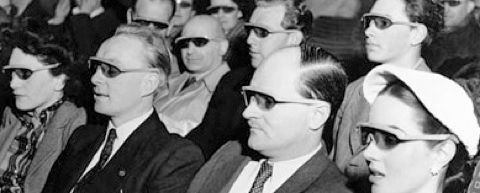Previous – 11. Tales From The Heart | Contents | Next – 13. All Or Nothing At All
We’re honored to be able to publish Stan Taylor’s Kirby biography here in the state he sent it to us, with only the slightest bit of editing. – Rand Hoppe
GHOSTS IN THE ATTIC
His studio went from the spacious attic in Mineola, to a small cramped basement at the new house. Neal remembered; “The basement room was tiny (just 10 feet across) and the walls that separated it from the rest of the cellar were covered in stained, tongue-and-groove knotty pine with a glossy varnish. Dad’s drawing table faced a beautiful cherry wood cabinet that housed a 10? black-and-white television. To the left of the cabinet was a beat-up, four-drawer file cabinet that was stuffed with Dad’s vast archive of picture references to, well, everything. I could sit for hours and just mull through musty old folders with bayonets, battleships, medieval armor, cowboy hats, skyscrapers, satellites — countless files on countless subjects. And — much out of character for my father — that metal cabinet sat beneath a stuffed and mounted deer’s head. I can’t remember where he said he got that damned thing, but it was always there. The things you remember…” This brings a smile to the author who stares up at a wooly stuffed Buffalo head his wife unexplainably bought.
Sadly one of the core members of the studio passed when letterer supreme Howard Ferguson died in late 1950. Gone, sadly were those great multi-font splash page blurbs that opened every S&K tale. He was replaced by an almost equally nimble letterer in Ben Oda. Oda was a brave young paratrooper during the war that had come to Simon and Kirby by way of Eisner/Iger. The Japanese/America vet would letter many syndicated news-strip and become a mainstay with Simon and Kirby.
The grumblings about comics content was escalating as local groups began pushing legislators to censure comics. The editors of Gleason’s Crime Does Not Pay took a proactive stance. The numbers are wonky, and the following issues showed no difference whatsoever. Worse days were just around the corner.
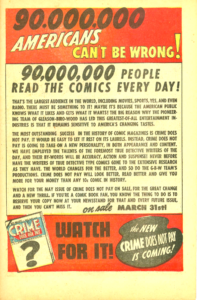
Dell Comics had reached the pinnacle. Its mix of licensed products and flooding the market moved it to the top of the chain. In an attempt to reach the public, it instituted a new club. In 1950 Dell Publishing Company introduced their Dell Comics Club as a means of attracting new and continuing subscribers to their series of comic books. To become a member of the club, all you had to do was buy a one-year subscription to any of their comic book titles. Then in addition to the comic books, you receive an official membership certificate in the Dell Comics Club along with a group portrait of the principle Dell Comic characters-minus Disney characters. The club lasted a couple years.
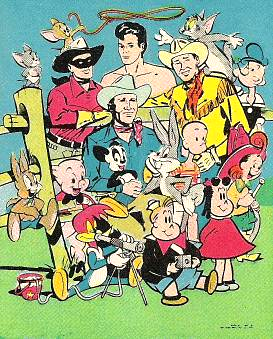
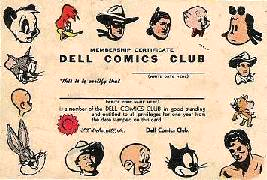
Interesting that Dell’s merchandise never featured any Disney characters-their biggest seller
The Fifties started horribly as the long years at a sewing bench caught up to Ben Kurtzberg. His death was a terrible blow to Jack. Jack’s feelings for his dad were conflicted. He knew his father loved him. But Jack found it hard to forgive the poverty and defeat he felt his father bore. The doting father who would carry his son around on his shoulders had too soon become the quiet, passive downtrodden man who struggled to care for his kids. Jack hated the poverty and the shame. He would never let his wife and children down as had his father. Mama Rose did not take the loss easily; she became more withdrawn and reflective. Even the grandkids failed to brighten her spirits. Brother Dave was doing fine with a floor refinishing company, and frequent visitor to the Kirby home; he became the defacto baby sitter when Jack and Roz wanted to hit the town. The kids loved him; he was like a second father.
The entertainment tastes of kids are fickle. What is popular one day is trash can filler the next. So it was incumbent on Joe to keep an eye on trends and for S&K to jump on board when needed. It was impossible to always be the spear head of new trends; some times you must be the caboose, following behind the engine.
After the war, all eyes turned towards a new medium. TV had entered the lexicon and with it a new source of cheap entertainment. By 1949, over 75% of the states had commercially licensed stations. The most popular programming were the hundreds of western movies made in the 1920’s and 30’s. In 1949, two of the most popular movie characters got their own all new TV shows. Hopalong Cassidy and the Lone Ranger became the country’s most popular stars and the idols of kids everywhere, and the comic industry had a new source for inspiration. They were soon followed by Gene Autry, Roy Rogers, Davy Crockett and dozens of others. It would become TV’s first big fad. There had been western comics since the very beginning; Joe Simon’s first story was a 6 page western for some long forgotten title. Jack had Lone Rider. But starting in 1948, mirroring the growth on TV, sales of western comics jumped dramatically and by 1950, they had expanded to almost 20% of the market. All the publishers were jumping on this horse. It was too big a segment for Joe to let slide.
Ernst Gerber theorizes;
“The war ended, super heroes faded away and it was time for more likely heroes…. Ask yourself what were the most often viewed movies of the early 50’s. Times up. Westerns, westerns, westerns. What you become fond of on television you want in comic books. TV became the medium which helped western type comic books to immense popularity.
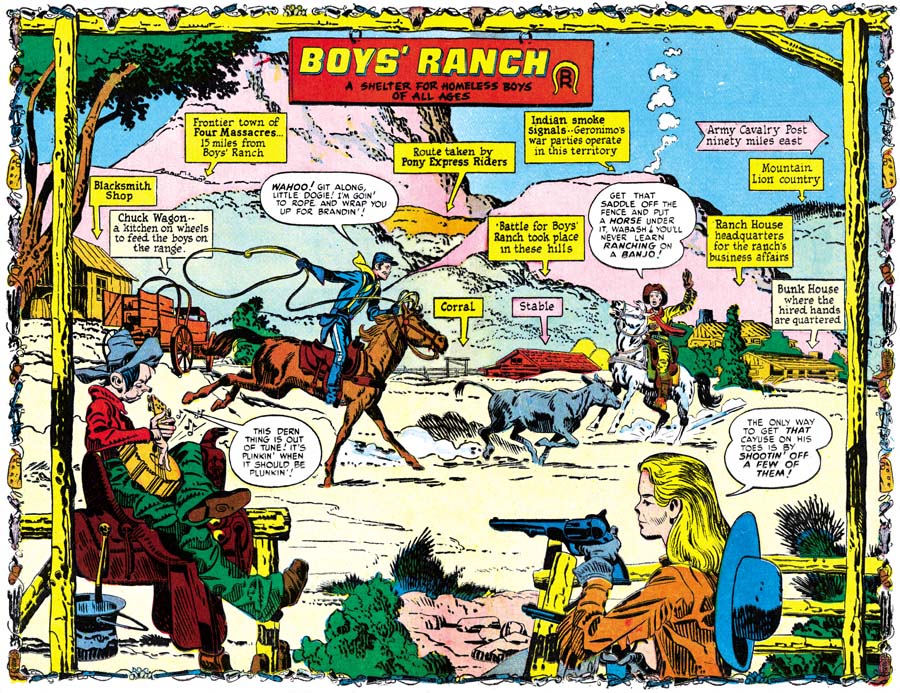
The Kid Cowboys of Boys’ Ranch, or simply Boys’ Ranch premiered with an Oct 1950 cover date. Once again Jack and Joe were working with Al Harvey and Harvey Publications. Joe always seemed to do his best for Al Harvey, and Boys’ Ranch just might be the crowning jewel. Some historians rate the series as the best work ever done by S&K, and possibly the best ever done for comics. Jim Simon, Joe’s son states that “Jack and Joe believed that their kid cowboy comic book was an artistic masterpiece that transcended the comic books of the time.”
Kirby notes in a forward to the Boy’s Ranch reprint; “In view of the meaningful psychological content woven into its total cloth, Boys’ Ranch stands high above the so-called “products of its type,” and attracts the reader with the sheer wholesomeness of its approach. Yes, the timeless struggle between good and evil continues unabated, as it must, in normal human existence. In the world of storytelling, it is severely heightened and probed in order to achieve the level of drama sorely needed when the point must be made. Boys’ Ranch never flinches from this purpose! Boys’ Ranch makes its point!”
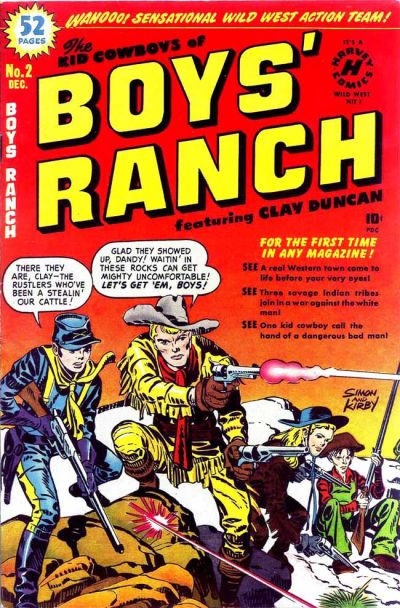
The concept was classic S&K; a group of young orphans whose adventures lead them to a small Wild West town, where they band together to help a boy hating rancher caught in an Indian uprising. In the middle comes a typically S&K style stoic ex-scout of heroic proportions to join them. During the battle, the rancher is killed, but not before bequeathing his ranch to the young kids. It was decided that the scout would become the foreman of the ranch, whose job it would be to watch over and teach the young boys.
The young boys followed the usual template for S&K kid groups. Kirby said; “Each of our characters was a part of that formula, and reflected his reactions to it with a sincerity shaped by his individual background.” The handsome all-American boy was Dandy, an ex-Union soldier restlessly traversing the West looking for adventure and romance. The goofy one was Wabash, a Southern hillbilly drifting aimlessly from his home in the Ozarks. In perhaps homage to his hillbilly army buddy, mountain folk would turn up quite often in S&K stories during this time. The young scrapper was Angel, the most neurotic and feared gun in the west, and controlling those guns was the hottest headed little firebrand ever created. The angelic face framed by flowing blond locks masked a fearless cold hearted loner. The heroic guardian had quite a portfolio. Clay Duncan was orphaned as a child, his parents killed by white outlaws. Raised by an Indian chief and half-brother to Geronimo himself. Learned in the ways of the Indians, he is turned over to a white scout to be the voice of peace between the two peoples. He became a scout for the US Army and a legendary Indian fighter. The white scout is killed by a renegade, and it is to avenge his friend that the legend of Clay Duncan begins when he has a gun duel with the killer. This template would be used again and again whenever Kirby created a cowboy hero. Clay Duncan was a man of few words, with great courage and skill. The cast was filled out with Wee Willy Weehawkin the ranch’s grizzled cook. Palomino Sue was a female addition, orphaned when Indians killed her wagon master father, this wild beauty soon developed a crush on Clay Duncan. For Clay’s part, Palomino Sue was just another distracting child who constantly ignored his orders. The last regular was an Indian cub named Happy Boy-ever smiling and silent as a totem, he became the ranch mascot.
The art was glorious, never more lush and natural. The landscapes were breathtaking. Joe says that the boys really researched this strip like no other. The grandeur of the West may have provided Jack with his greatest inspiration. The double spreads that anchored every issue were eye popping tableaus of mythological stature–The equal of Remington and Charles Russell. The inking was heavy, solid, and naturally textured. It was as rugged as the crags and cliffs of the West.
The geometric shadows used so heavily in the modern day hard and angular architecture disappeared in the naturalistic westerns, no shadow snakes, and no arcs or halos over the heads.
As good as the art was, and it was Kirby’s best, what separated Boys’ Ranch from other western comics was the stories. They were tight, spare little morality plays. They were simple when needed, but complex when called for also. The stories were direct, with little padding. Famed western writer Louis L’amour had some advice for writers that seemed to have been borrowed from S&K’s approach. “A novel’s action should start on page one, line one. Too many writers talk about what they’re going to do before they say it. There are lots of other things competing for people’s entertainment time –they don’t have to read my books. You’ve got to start with something happening.”
These were the most literate scripts ever provided by S&K, and the action began on page one, in fact, the action started on the covers and never subsided. The plots were action filled, and tense. The characters were well developed and concise in their roles. Romance was sprinkled in and the melodrama moved the action. When critics and historian rate various S&K stories, one invariably tops the list–Mother Delilah from BR #3. A story of Biblical allusion, and Shakespearean poignancy, the poetic narrative tells a tale of jealousy, deceit and finally redemption. The titular character is the fiercely proud owner of the local bar. When her romantic feelings for Clay Duncan are rejected, she picks one of the children to get back at him. She chooses Angel, and slowly wins his trust and love. She then betrays the young boy and destroys his confidence and newly learned trust in others. It is Clay’s job to help Angel regain his sense of purpose and in doing so a tragic gunfight occurs. Mother Delilah makes the ultimate choice and sacrifices herself to protect Angel.
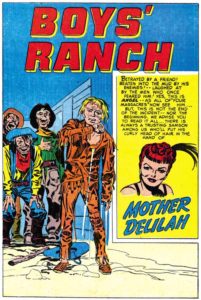 Richard Howell describes it thusly;
Richard Howell describes it thusly;
“The story ends tragically, but with Virgil’s (the town poet) narration underscoring the hope of redemption in masterly effective poetic prose-complemented perfectly by the restrained drama of the visuals. Throughout the story, the conflicting desires of the principals are clearly depicted with an assurance and intensity that transcends craft and moves into art. Boys’ Ranch #3 is moving, involving, touching, exciting and – ultimately- a fitting tribute to the creative vision behind it. Jack Kirby comics–or comics- have rarely, if ever been better.”
Mort Meskin would take on an increasingly important role as the series went on.
Tragically, the series fell victim to poor sales, and Harvey cancelled it after six glorious issues. Once again S&K couldn’t give their friend Al Harvey a hit. The same can’t be said about another new series that S&K introduced the same month.
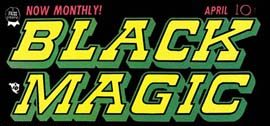
Horror comics had always been around- usually as a sub-genre of the sci-fi and fantasy genres. When Max Gaines died in 1947, his son Bill took over the small EC label of comics. In 1950, EC was getting by with six titles, none selling particularly well. Gaines and his editor Al Feldstein decided to make a change. The new comics, or “New Trend” as they were to be called included Vault of Horror, Haunt of Fear, and Crypt of Terror. These three titles would usher in a new genre that sparked the next wave of hot titles. EC’s graphic horror titles were the first and best of over a hundred titles devoted solely to the depraved, lurid depiction of violence, gore, and gruesome horror. This was the first genre devoted squarely to man’s inhumanity and its worst instincts, not its best. But boy were they fun! The horror genre encompassed the occult, sci-fi, monsters, crime and any other subject that could scare the bejesus out of a kid–from ghosts and zombies, to madmen with axes.

Headlights and horror – nice mix
“Black Magic came about because we saw a trend emerging in comics back in the Fifties; something begun by others but which we had to pick up on if we didn’t want to get left behind. It wasn’t a new idea to use all those ghosts and spooks, but it was a salable idea at the time and we were fortunate to get involved in it early. We had to compete with E.C. so it was tough.” Joe recalled.
S&K and Prize didn’t ignore the trend. Their response was “Black Magic”, with issue #1 bearing a cover date of Oct. 1950, just 5 months after Vault of Horror. The focus was more on the occult than on the blood and guts sociopathic monsters of EC.
Jack explained: “I didn’t have an affinity for horror. But I knew that commercially, it was viable. That’s why we both finally did it.”… We didn’t do horror in the sense of haunted houses or people with masks the way you might see today; something lurking in an anteroom. Our stories were more like peasants sitting around a campfire. Ours didn’t run to bloody horror. Ours ran to weirdness. Joe and I were wholesome characters. We weren’t guys that were bent up on the weird and the bizarre. We were the kind of guys who wouldn’t offend their mother, who wouldn’t offend anyone in your family, and certainly not the reader.”
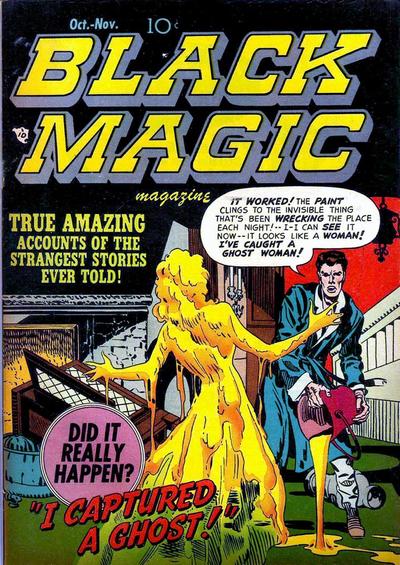

Stay out of the attic
Joe concurred;
“Black Magic was an excellent comic book with art and stories about the supernatural that were pure as Ivory Snow compared to EC Comics and the rest of the horror field.”
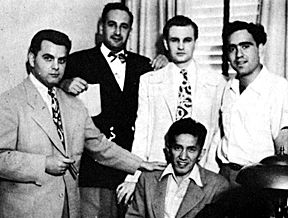
Kirby, Simon, Draut, Stein and Oda (seated)
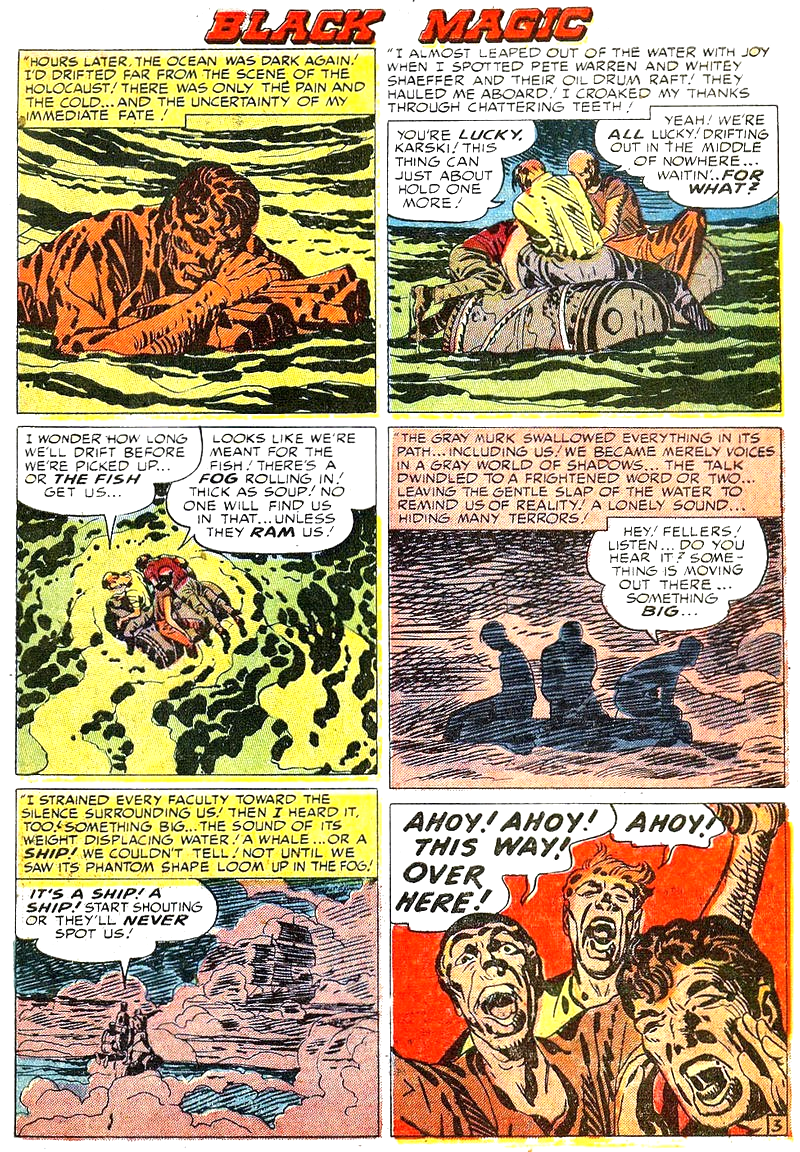
The coloring was the best
Ivory Snow? Maybe not, they had werewolves, and violence, just not the lurid bloody depictions of some companies.
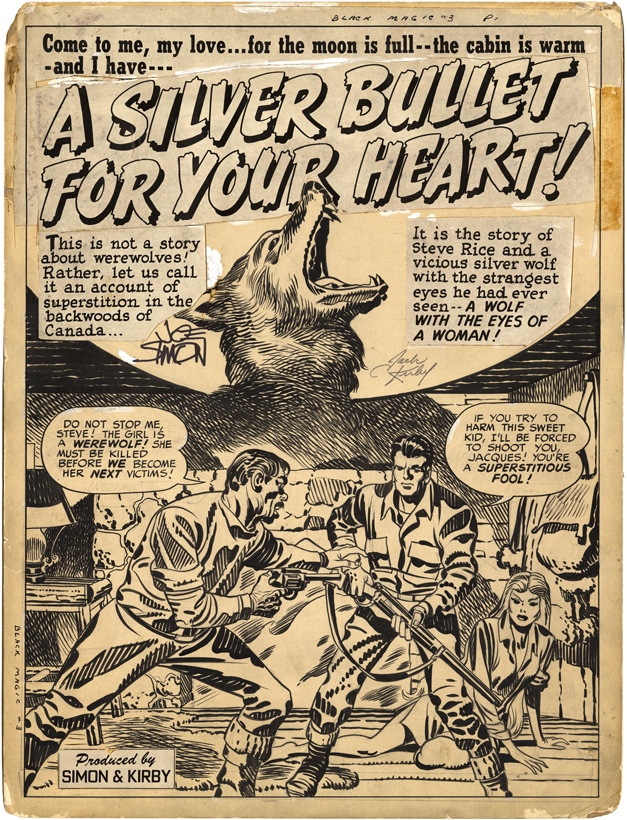
Non-gory maybe but they were scary
Jack might not have had an affinity for horror, but he drew the first 33 covers for the series, and they were beauts! They were scary, atmospheric, horrific but not clinical in their depiction of gruesome. The stories were interesting and suspenseful, thematically connected by Old World mythology, and psychological torment. The series was a hit and would continue, with a short hiatus for 11 years.




Jack notes; “E.C. was very basic in their approach to horror. By that I mean, they left nothing to the imagination; same with most of the other horror producers. That may have been part of their downfall. You can only throw that kind of thing at the public so long before they develop immunity to it. I think we were a little more restrained with our stories, but that may be because we were putting out a lot of romance comics and it mellowed us somewhat.”
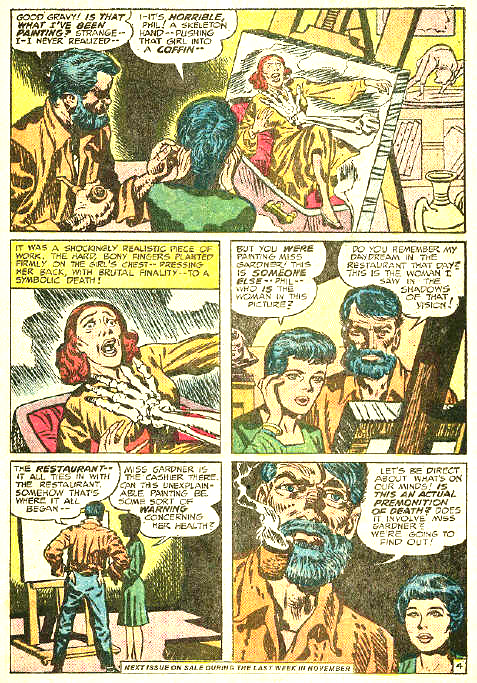
You knew Kirby would pull the painter gambit
More than anything, the horror genre would awake the sleeping beast of societal backlash against the industry. So gruesome was the depiction of horror and brutality that mothers, and church groups, and parental groups reacted with calls for boycotts, and book burnings. When in 1954, a prominent psychologist Frederick Wertham published a damning screed on the dangers of youths reading comics, the Government got involved and held hearings concerning the connection between comics, and juvenile delinquency. But that’s a tale for a later chapter.
On June 17, 1950, reality became the horror. Julius Rosenberg, the young Jewish anarchist from Jack’s Lower East Side neighborhood was arrested for espionage—selling atomic secrets to the Soviet Union. Shortly after, his wife Ethel was arrested as an accomplice. Both were children of Jewish immigrant families living on New York’s poor Lower East Side. Their young histories are remarkably similar to Jack Kirby’s in many ways; the Rosenberg’s were very ordinary people. Like many people who came of age during the grinding poverty of the Great Depression, Ethel and Julius Rosenberg were radicalized and joined the social struggles of the time. Julius’s mother and father, both Russian immigrants, worked in garment sweatshops in New York City. “We were so poor,” one of Julius’s sisters recalls, “my mother would hard boil an egg so that she could divide it among us.” Julius’s father was a shop chairman and an active trade unionist. For this, he was blacklisted. Julius was also radicalized by political causes of the time. Ethel came from a similar background. Her father, a Russian immigrant, made a meager living operating a sewing machine repair shop. At the age of 19, Ethel was fired from her job as a clerk at a shipping company after leading 150 women workers in a walkout in 1935. Like Kirby, they were looking to escape. Unlike Kirby, there was no Harry Slonaker to direct their anger and restlessness towards a more promising goal.


Firebombers delight – Coincidental S&K cover
The Jewish community was in chaos; torn between its desire to protect its own vs. their true patriotic fervor. But there was a major problem that the organized Jewish community was forced to confront—a problem stemming from the long involvement of the mainstream Jewish community in communism and the far left, at least until the end of World War II, and among a substantial number of Jews even after this period. They had bonded with the new Communist government after it overthrew the Czar. The Czar was their natural enemy, and as always, the enemy of your enemy is your friend. In Jewish Organizations’ Response to Communism and Senator McCarthy, Aviva Weingarten points to a “hard core of Jews” who continued to support the Communist Party into the 1950s and continued to have a “decisive role” in shaping the policies of the American Communist Party. (CPUSA) Andhil Fineberg of the American Jewish Committee wrote about devising Jewish defensive strategies over the repercussions of the fact that the great majority of communist spies were Jews. Fineberg suggested that the best way to combat this threat to Jews was to de-emphasize Jewish group identity of ‘good Jews’ like Bernard Baruch as well as ‘bad Jews’ like the communist spies. Identifying people like Bernard Baruch as Jews ‘reinforces the concept of group responsibility’ and ‘the residue in the mind of the average American person whom the editorial is intended to influence, is likely to be, ‘But why is it all those atomic spies are all Jews?’ Fineberg argued that an attempt by Communist Party members to portray their persecution as anti-Semitism would be ‘devastating’ to Jews generally and recommended that the AJCommitttee reply to charges linking Jews and communism to the effect that criminals operate as individuals, not as members of religious or racial groups.'” After a short trial, the Rosenberg’s were sentenced to death.
Senator Joseph McCarthy was just beginning his crusade against Communists in the government when the Rosenberg’s were arrested. Their case became great fodder for all of McCarthy’s histrionics and fear mongering. But even McCarthy was wary of outright opposition from Jewish voters and was very careful in separating anti-Communism from anti-semitism. McCarthy surrounded himself with Jews and let Jews like Roy Cohn and David Schine do all the heavy lifting in going after the many Jews deeply imbedded in pro-Soviet activities.


Serious Sen. Joe McCarthy – the not so serious Jack and Joe
Black Magic issue #22 (Mar. 1953) was especially chilling. The lead story bore one of Jack Kirby’s more inspired splashpages. The center figure showed a man staring out into a small secluded lake looking at a glowing disk. Surrounding this figure was a collage of newspaper stories about UFO’s and unexplained flying disks. The story tells of a brave man who finds and explores a crippled flying disk. It seems a neighbor had already found and claimed the disk for himself. When other neighbors find the disk, the claimant sets to fighting them to enforce his find. A war for control erupts. A small unearthly figure comes out of the shadows and witnessing the brutality pushes a button in order to stop the fighting., The lone brave man sees the figure push the button and decides to run for his life. He escapes just as the disk self-destructs in a soundless explosion. He wakes up in a hospital and tries to tell the doctors of his find. They laugh and pass off his ramblings as that of a madman. Yet forever more the brave man would bear the scars of the cosmic ray burns on his face; warning us that there are monsters–they are the earthlings next door, not the man from space.


Who’s the real monster? – Sometime the “bugs” were bad
Besides being a wonderful S&K morality play this tale really stands out. I think it is an important step in Kirby’s growth. This may be the first use of collage in a Kirby page. Jack specifically cut and pasted newspaper accounts and worked them around a hand drawn scene to create a combined work of art. Some note a difference since using newspaper newsclips is using the material for what it is, the text is the message. . While Jack’s later use uses newspaper and magazine art in a more fantastical nature in order to create a different message and context to the art. He changed the meaning of the chosen art. I understand, but this seems technical and tacky to me. There is no contextual difference in collage– A collage may include newspaper clippings, ribbons, bits of colored or hand-made papers, portions of other artwork, photographs and other found objects, glued to a piece of paper or canvas. The origins of collage can be traced back hundreds of years, but this technique made a dramatic reappearance in the early 20th century as an art form of novelty—No where is the contextual message mentioned. No mention of fantastical or otherworldly is needed for a collage—it is the added bits taken from a pre-existing work—that make it collage.
The next remarkable aspect is just such a contextual idea. This is the, or one of the earliest use of post-war atomic pop culture by Jack. The use of newspaper clippings spotlighting the cultural rise of UFO appearances, and such conspiracy growth after the war makes the Kirby story just that much more topical. Kirby went out of his way to give an added strength and relevance to his story by showing current fascination, yet avoided the debate and disdain often thrown to the conspirators. Was Kirby’s imagination set off by this cosmic debate?
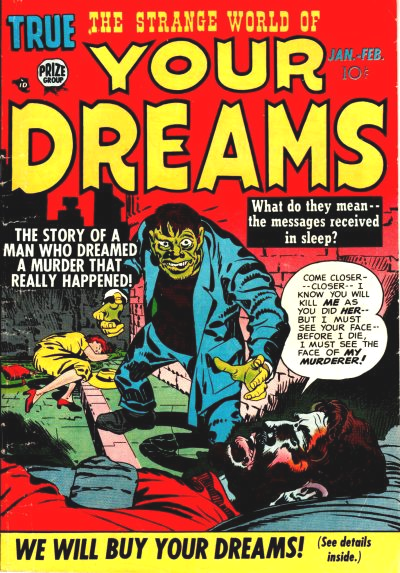
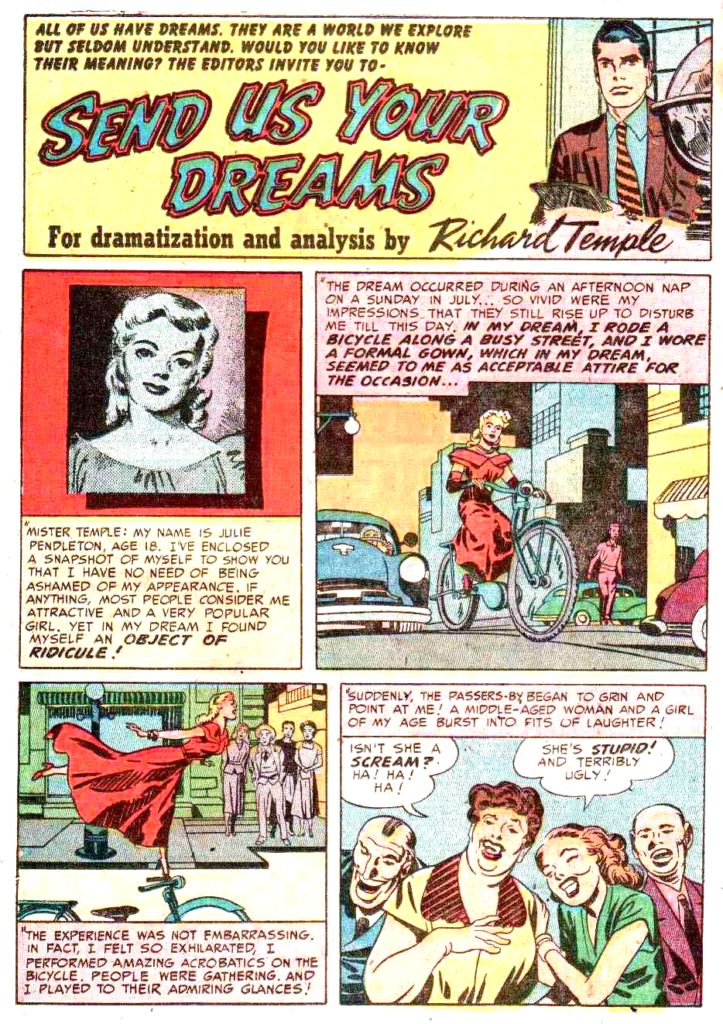
1952 would see the team expand again as they added in Strange World of Your Dreams as a companion piece to Black Magic. This was based on a Mort Meskin idea and was credited to Mort as editor-though several Black Magic stories had used the same “dream” template. Word is the idea came from Mort’s own reliance of psychotherapy. The title’s host, Dr. Richard Temple was a very busy guy; always had Jack Kirby’s pipe handy. Neal says that at the holidays, Jack was always easy to buy for; A new pipe or a box of cigars. He once had a fixation on corn cob pipes. They also added in Young Brides to help out the romance books.
The horror genre was never as important as many would assume. It had a sociological import, and impact way beyond the actual sales figures. EC was never a top tier publisher. Its lasting impact would come later with satire and MAD Magazine. Even in the mid-50’s, the percentage of horror titles never exceeded 16 percent of the market, and that for only a short period
The early 1950’s were the best of all times for Simon and Kirby. They were working on as many as 5 titles at a time. The studio was a well polished machine with a small core group of top rated artists, and a select group of back-up artists orbiting the main body doing top notch work. More importantly their families continued to grow with the births of Jim Simon, and Barbara Kirby in 1952. Though it was a small tight group, occasionally a new face would show up and shake up the team. Jack said “We did our best to give everybody a chance for a job, but I would be embarrassed to tell you who I turned down and even more embarrassed to tell you who we let go. Jerry Robinson, the great Batman artist, and partner with Mort Meskin, had taken a teaching job at the Cartoonists and Illustrators School. Among his students, one stood head and shoulders above the rest. A shy erudite young man from Youngstown PA named Steve Ditko.


Genial Jerry Robinson – Merry Mort Meskin
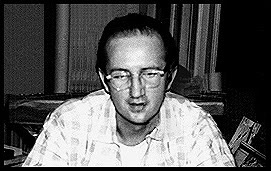
Reclusive Steve Ditko
Jerry remembers; “When I’m asked about students I of course always mention him. “Steve was quiet and retiring, a very hard worker who really focused on his drawing.” “He was very bright. I knew it right away. In fact, if I recall correctly, I got him a scholarship for the second year, so he was in my class for two years. When I would see students of Steve’s ability I would recommend them to a publisher.” For Steve Ditko, the respect is mirrored right back to Robinson. “Jerry Robinson was a great teacher for teaching fundamentals in how to tell/show comic book story/art. What one learns, knows from seeing, studying other’s artwork is mostly visual. But what one learns from a teacher like Jerry is how to use one’s mind with solid comic book panel/sequence principles. It is that basic understanding that makes a comic book panel effective, dramatic, [and] visually work for a story/picture integration and continuity creating a whole unique reading/seeing experience.” Ditko’s style was perfect for fantasy genre work. It was heavy in atmosphere and texture. His inking was dark, shadowy, and liquid, oozing with suspense. His characters were uniquely creepy and singular. His compositions were suspenseful and dramatic. Yet Steve recalls his early years, and the lost effort of an amateur. “I was self-taught, and you’d be amazed at the hours, months, and years spent practicing bad drawing habits.” Steve’s recollection mirrors Kirby’s years at a hit and miss beginner.
When brought to the S&K studio, Steve was given a script for a Black Magic story. “A Hole In His Head” appeared in BM #27 (Nov. 1953). This was the second published work in what would become a legendary career. He also contributed stories in BM #28 & 29. Steve’s time at S&K must have been magical; he met and worked in tandem with one of his artistic heroes–Mort Meskin. The reticent Ditko recalls; “Meskin was fabulous. I couldn’t believe the ease with which he drew… I loved his stuff.” “No one who reads a Meskin drawn story is ever in a fog as to what is happening. Not only does Meskin tell a story extremely well, but he does it in the most difficult way.” A testament to Mort Meskin’s talent and gift for avoiding the super-ficial and gimmickry as opposed to concise pacing and clarity of image. After finding a new home at Chartlton, Ditko’s early career was cut short in early 1954 when he returned to Pennsylvania suffering from Tuberculosis. Steve would return in 1955 and his and Jack Kirby’s paths would forever be intertwined. Steve was a fine fit for Charlton; their loose editorial policy was the perfect fit for someone so stringent in his philosophy. Unfortunately whenever Steve came forth with a personal project, even the company least worried about sales was still forced to cancel it quickly.


Classic Ditko isolated questioning subject – The girls weren’t pretty but he told a story
Another itinerant artist, Jack Katz talks about his short time at S&K.
“Jack would work at his own desk there and Joe would come in during the morning and subtly stare at us. Jack would go for lunch, and when he came back Joe would leave for the day.
You know how I learned to ink? Jack sat me down one day, He said, “This is what you do.” He took one of my drawings, and he inked it with a brush. I’d never seen inking that good in my life. I said, “Jack if you could ink so good, why do you let—?” He said, “I don’t have the time.”He said, “This is what I want you to do. You apply the blacks like this. This is what you do with your camera angle to make the background stand out. Jack would fill in all kinds of black areas in the background. As an inker, I don’t think there could have been anybody better if he had done his own stuff himself.”
“One of the things they had in the office was the Sunday Hal Foster Tarzan strips, almost from its inception…everyone in the office was using them for swipes. Kirby never used swipes. I’m being very straight about that. If he did it was for reference, I never saw him erase anything either.

Just breathtaking stuff. Hal Foster Tarzan
Jack would get in early, he was always there before I came in. He left late. Jack wrote as he drew, he also worked from scripts, but he would use them as a template.”
Katz says the studio was a serious place, but Mort Meskin specialized in getting Kirby’s goat.
Jack would be lost in thought on his pages and Meskin, he says; “Get up!, Get up!” and a girl would be walking around in a bathing suit. And Jack would say, “Would you sit the f**k down. ”This happened almost every day. One day Mort brought in some pornographic toys, Queen-sized fake breasts. He shows them to Kirby. Jack says, “What are you doing?” Mort puts the breasts on the floor and starts jumping up and down on them. Jack told him to stop, and get back to work. Mort said, “I can’t because I had a date with a disgusting pig, and I’m taking out revenge. Mort would also slip nudie pictures silently into the romance artwork just to hear Joe Simon erupt.
Another comic professional also credits Jack Kirby for starting up his career, but in a totally different way. From an interview with Daniel Best, Vic Carabotta says;
“I made some samples up and we canvassed New York City and went to every publishing house you could think of. One of them, of course, was Timely Comics which ended up being Marvel later on, but nothing really happened and I couldn’t get in to see anyone like Stan Lee. Finally my wife and I ended up with a cup of coffee walking the streets of New York and I got to see Jack Kirby. He’s really the one who got me started. My wife and I went over together to Jack Kirby’s office, which was then called Simon and Kirby, and Jack took me into his office and looked at my stuff. My wife sat in the lobby and by this time she was about eight and half months pregnant. So I went into Jack’s office and he looked at my stuff and said, “Well this is nice.”


Jack Katz – and Vic Carrabotta
Because I was an amateur and I don’t think I was very good at the time. [laughter] So he walks out into the lobby and while he’s telling me, “You know Vic, your work is nice, but don’t call me, I’ll call you.” It was the old story, the brush off, and as he walked out my wife stood up and I said, “Jack, this is my wife Connie.” He looked her up and down and he did a double take and saw that she was pregnant and what ran across his mind was, “This poor guy, he needs work,” and he said, “How are you?” and introduced himself to my wife and said, “By the way, have you seen Stan Lee at Timely Comics?” I said, “Yes Jack, I went there but I couldn’t get to see Stan.” I was walking around with a pack full of amateurish work; I couldn’t even afford a proper portfolio. He said, “Well, wait a minute,” and he went back into his cubby hole and he writes a letter and sealed it and said, “Take this back to Stan now.” So I took it back to Stan and got past the secretary and I was sitting across the desk from Stan Lee. Stan was a very casual guy and had his feet up on the desk and he said, “Oh, Jack says you can draw this and that,” and I said, “Yes Stan, would you like to see my work?” and he said, “No, that’s ok. Here,” and he threw a script across the desk and said, “I want this back in a week.” And that was the beginning of my comic book career. I never knew what was in the letter; obviously it was Jack telling Stan to help this poor guy. And that’s how I got started in comics. Had it not been for Jack Kirby I’d probably be laying bricks with my cousin or something. [laughter]
DB: What were Stan and Jack like back in the mid ‘50s?
VC: “Jack Kirby was a heck of a nice guy. He was always a model guy and I felt sorry when he died. A very, very nice man.”
1953 would find the studio with another challenge. A couple months earlier, St John Publishing had produced the first 3D comic. Archer St. John had come from Chicago. His earliest claim to fame is being shot at and beaten by Al Capone when his brother and he printed some scathing exposes on Capone’s attempt at rigging a local election. Archer came east and published some hobby magazines that evolved into comics when he began filling the hobby magazines with comic strips. By some means, he hooked up with the Chesler Studios and began publishing odd comics with their product and artists. His most lucrative work was when he obtained the rights to Mighty Mouse, and when artist Norman Maurer obtained the rights to produce Three Stooges Comics. Norman had married one of the Stooges daughters and controlled several aspects of their finances. It was Leonard Maurer who perfected the 3D process and arranged with Archer to publish all of his comics in the 3D process.
Leon recalled:
We then took the pages and the concept to Archer St. John. Initially skeptical, St John was shocked when he put on the makeshift glasses and viewed the artwork. He bought the concept on the spot and for it received a 25% stake in a partnership with the Maurer’s and Kubert in the American Stereographic Corporation, the company formed to license the new 3-D Illustereo process. For his financial input, St. John also received a six month head start before the process would be offered to other comic book publishers. Archer insisted that they start with his bestselling book, Mighty Mouse. Mighty Mouse 3D (Sept 1953) was a huge success. The 3D artists/creator Joe Kubert claims that it sold over a million copies @ .25 each. In fact, it was initially released on July 3, 1953, and eventually saw the full printing reach 1,200,00 copies.The profits paid for Joe’s first house.
Leonard Maurer, tells all in an interview.
“Even though it was Joe’s remark, ‘Gee, wouldn’t it be great if we could make a 3-D comic book?’ (When he, Norm and I were driving past the marquee of the Paramount Theater where Bwana Devil 3D was playing) that got me thinking about 3-D comics. Later, while driving home to Queens over the Midtown Bridge, the whole process [of] depth shifts suddenly popped into my head. “In one long night, I drew the first 3-D comic page entitled “The Three Stooges in the Third Dimension” Early the next day, we waited for the midtown Manhattan’s Woolworth to open in order to purchase lollipops. “We figured we could get red and green cellophane from lollipop wrappers.” Norman recalled; we bought two packages and made a funny pair of glasses which, believe it or not, worked perfectly.”
“We gave St. John a 25 percent partnership in our licensing company, along with a 6 month’s head start for his publishing company in exchange for financial guarantees for Norman and Joe as Editors, and myself, as supervising producer — with a secret studio to be set up for production of the Mighty Mouse book”.
“I didn’t realize that the 6 month’s exclusive was what triggered Sol Harrison,(DC) Stan Lee(Atlas) and all the others to knock us off as quickly as they could, since my hands were tied in offering everyone a license. I could understand them doing this, however, since the success of Mighty Mouse, with its precision offset printing, along with my carefully designed and engineered die cut glasses insert, and selling for a quarter with the same number of pages as a dime book, was big, big news. And there were equally big financial stakes involved… especially, since it had an unheard of 100 percent sellout of its initial 1,000,000 print order. We even had to reprint an additional million. That was some leap. Considering that the normal print order at the time was under 300 thousand. All of this was based on our combined advice and suggestions to St. John. I also warned him not to go too far overboard with the next books, since I didn’t think the fad would last more than two seasons. I recognized the danger of off register [printing] too, especially in the ‘y’ axis, and knew that as soon as they tried to do it on the standard comic book web letterpresses, with their notoriously poor registration, the resultant headaches would bust the whole market apart.”
“Suffice it to say, by the tenth or eleventh 3-D book, said Joe, sales were down to about 19% sell thru, so we had to stop publication of 3-D’s. Leon always said that the attention span was limited and the fad was waning. What really hurt was the hoped for 6-months head start ended up being non-existent. Just one month after St. John’s Mighty Mouse started the fad, Dell Publication put out 3-D-ell Rootie Kazootie. Since the books took up to 5 months to produce, it remains a strange coincidence, or an unsolved mystery as to how Dell came up with a 3-D magazine so quickly. Before long other companies like Harvey and DC got into the business and really watered down St. John’s creation.
“What eventually bankrupted St. John was his attempt to block all the other publishers by buying up, in carload quantities, all the factory output for over 6 months of dyed acetate (made to my specifications, and produced by Celanese Corp.) He also bought up carload quantities of comic book newsprint paper. He didn’t succeed in blocking everybody, since there were other major acetate and paper manufacturers, but he did hold up a few, and for a while, his books were of the best quality and led the market.”
When DC, and Dell, as well as EC jumped on the fad, Harvey took notice. After a couple of funny animal cartoon books, Al Harvey thought a super hero character was a great way to show off the new process and contacted the premier super hero team to draw it. In August 1953 Al Harvey contacted Joe Simon and asked for the boys to put together a 3D comic.
Though Joe was not impressed with the idea, he could never refuse Al Harvey, especially when promised 2X their usual rate, so Jack Kirby, Mort Meskin and Steve Ditko moved into a vacant studio at the Harvey offices and learned the tedious overlay process for achieving the 3D effect. Due to the tediousness, Archer was paying his artists 2X normal rate. Joe recalls in frustration.
“Drawings were done on hole punched plastic acetates set into pegs on the drawing boards, There were two to four dimensional planes, each a separate acetate requiring individual drawing, all part of the main drawing. It was extremely tedious work, rendering on the slippery, unfamiliar plastic, and matching the registration from overlay to overlay” “We worked on the project a couple of weeks and finally packed up, exhausted, glad to be back to our regular tasks, when we tabulated our time, it proved to be a financial loss to us.”
The result was Captain 3D, a superior effort 3D or not. Rumor says that the title was too late into the fad, and sales died and left Harvey in the lurch.


Harvey floods the market – good results at first
The art was prime Kirby, inked by Meskin and Ditko. The story was a typical mix of action and sci-fi telling of a dimension breaking hero, fighting a civil war with the Cat People. Kirby instinctively realized that for the 3D effect to work, the action must be thrust forward towards the reader. A second issue was planned, but Al Harvey called a halt. Sales had bottomed out. Joe would learn later that Bill Gaines had threatened a lawsuit from EC.
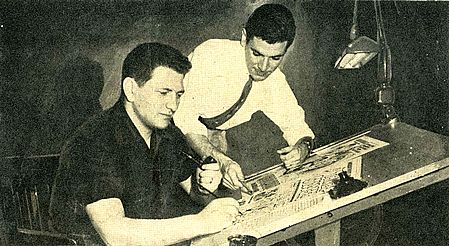
Joe Kubert at table – Norman Maurer standing
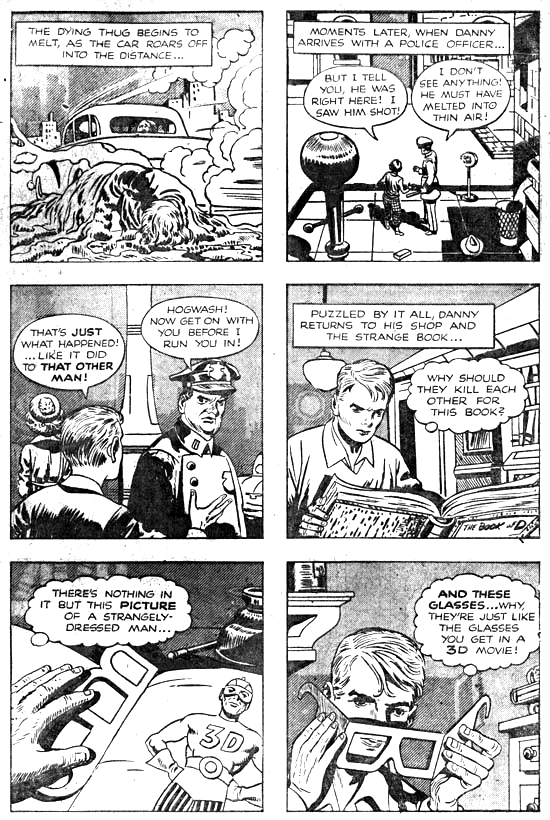
version of Flattened Kirby 3D – get some glasses
Bill Gaines was the publisher of the Entertaining Comics (EC) line that included MAD magazine as well as many controversial horror and crime comic books. He had taken over EC comics when his father, the legendary M. C. Gaines had died in a boating accident in 1947. He was also a 3-D photography enthusiast who owned a StereoRealist camera and when the St. John 3-D comics came out, began immediately to make plans for 3 issues of EC 3-D Comics. With a patent search, Gaines discovered an October 13, 1936 Patent (no. 2,057,051) by Freeman H. Owens which was a Method of Drawing and Photographing Stereoscopic Pictures in Relief and described reproduction of a newspaper cartoon drawing as a “stereoscopic relief picture” with separate parts of the cartoon “copied on separate transparent sheets” and “opaque on the back to correspond with the outline in each case.” The sheets, “advantageously celluloid,” were recombined and copied “to make the pair of stereoscopic views” by shifting them laterally.
“A month before its expiration,” notes Maurer, “Gaines bought the Freeman Owens patent — which never turned up in our patent search — from the dying inventor for a few hundred bucks.” Then Gaines initiated suit for patent infringement on all the publishers of 3-D comics including St. John, and Harvey. “That suit,” says Maurer, was “based on surreptitious individual tape recordings of meetings with Joe and Norman, where Gaines accused me of stealing the Owens patent out of the patent office (big joke). The lawsuit was eventually thrown out as baseless, but not before Archer St. John filed for bankruptcy and died soon after.


Last page of Freeman Owens 1936 patent – Ad for St. John’s first
It seems that the young Steve Ditko was impressed. In a very early comic story, Steve has two characters in a quiet moment talk about the 3D fad. The first character says to the other; “And this 3D picture was big as life…and twice as ugly. You felt as if you could reach out and touch the characters! The other adds; “I saw the shot myself! When those guns went off I shook as if I had been shot! The first man responds; “Those old flat pictures are good enough for…”
Perhaps Conway Twitty said it best: Fads are the kiss of death. When the fad goes away, you go with it.
Al Harvey met with EC’s lawyer and was happy to promise they would publish no more 3D comics, as he was left with a huge back stock of the damn things, when sales dropped like a ton of bricks after publishing a few more issues.
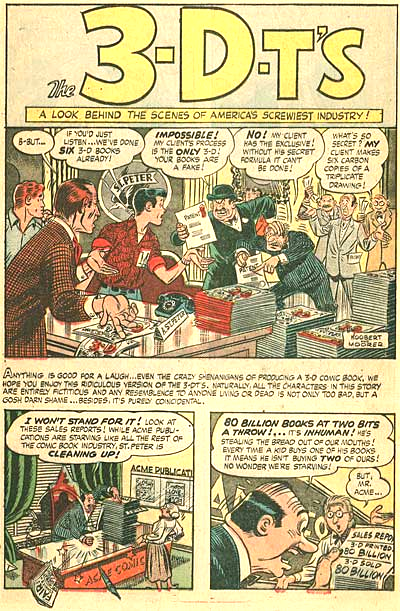
Joe Kubert gets the last laugh in Whack Magazine
Joe Kubert said; “”Each succeeding sale was less than the one before. Proving that gimmicks don’t last forever.” The companies were suddenly inundated with returns. St John, the company that originated the process went out of business, and Harvey was stuck with millions of the special glasses piled up in the warehouse. Once again a Harvey project cut short.
Fads do come and go, and this particular fad would come again, and Kirby would once again be involved.
Earlier in 1951, the lawsuit between National Publications and Fawcett Publications over Captain Marvel was heard. Joe made a cursory appearance for DC. The judge ruled that yes, Captain Marvel was a rip off of Superman, but National had let their copyright lapse, so they couldn’t enforce their copyright. National appealed and in late 1952, Famed Judge Learned Hand overturned the lapsed copyright claim and remanded the case back to the original court to decide damages against Fawcett for copying Superman.
In 1953, Fawcett and DC worked an out of court settlement whereby Fawcett would cancel all super-hero titles, plus pay a penalty. Fawcett wasn’t all that upset; the super-hero comics were no longer profitable as sales continued to fall. Their paperback business had become very lucrative. This put many artists out of work. Oddly, Fawcett would continue to print Dennis the Menace comic books.
The main Captain Marvel artist, C.C. Beck contacted Joe Simon and asked if Joe might come up with a new title for him to draw. Joe worked up a concept that he titled Spiderman. He then contacted his brother-in-law, comic writer Jack Oleck, and after a story conference worked out the details, Oleck took the idea home to work out a script. One change was that the title was amended to Silver Spider.
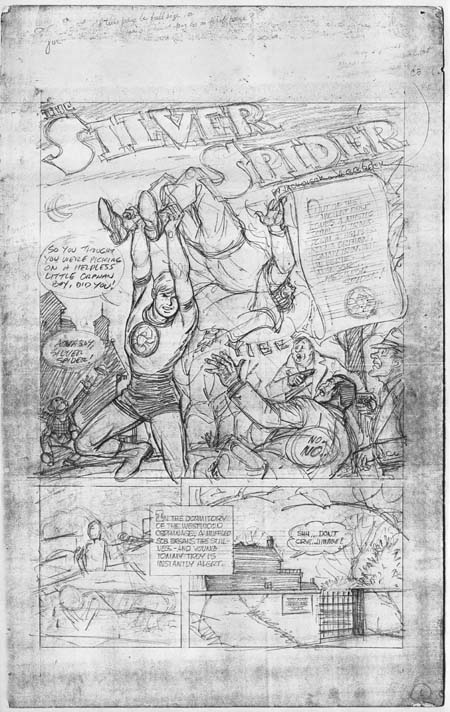
C C Beck, no powers, no uniqueness
Oleck returned with a script, and Joe gave it to Beck to draw. Beck returned with 8 sketchy, partially drawn presentation pages which Joe took to his friend Leon Harvey. The completed pages showed a young orphaned boy finding a magic ring that granted him a wish. His wish; To be as cunning and shiny, and slippery as a spider– a human Silver Spider. Leon turned the pages and script over to a young editor, Sid Jacobson, to review. Sid’s review was less than complimentary.
The name: strictly old-hat. Almost a take off on Green Hornet
Character : What powers does he have? From both stories, it seems that there is no exceptional gimmick involved. He barely being a strong man. I believe a hero should have some special power—a la Human Torch, Submariner or even Captain 3D’s seeing ability
On and on, Sid continued, completely tearing the concept down. His conclusion “I find nothing exceptional “I believe that Jack Oleck is capable of much more than this.” Leon Harvey passed on this project and Joe shelved it. One can wonder why Joe never offered the idea to Crestwood, where He and Jack were doing multiple features, or even produce it themselves under the Mainline banner. But it would play a large role in Jack’s life when it was rescued years later.
Previous – 11. Tales From The Heart | top | Next – 13. All Or Nothing At All


